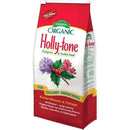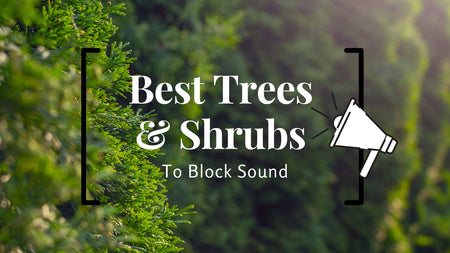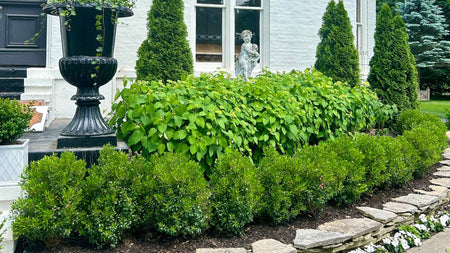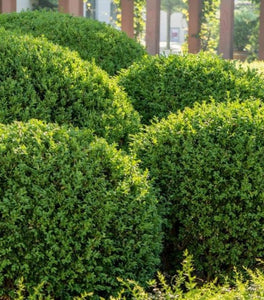
Images Depict Mature Plants
A Native, Boxwood-Like Evergreen With a Squat, Tidy Habit
Compact, “Tuna-Can” Shape That Stays Full to the Ground
Ilex glabra ‘Strongbox®’ gives you the formal, evergreen presence of boxwood without the disease and pest headaches. This dwarf inkberry holly naturally forms a broadly rounded mound, about 2–3 feet tall and wide, with dense branching that stays leafy all the way to the ground.
It's fine, glossy green foliage delivers a soft, refined texture that looks right at home in front of foundations, along walkways, and in mixed borders. Unlike standard inkberry, Strongbox doesn’t get leggy or bare at the base when grown in good light.
A Smarter Replacement for Boxwood in Modern Landscapes
As boxwood blight and other issues become more prevalent, designers and homeowners are turning to Strongbox as a durable, native alternative to boxwood. It offers the same clipped, evergreen structure but with improved tolerance to moisture, enhanced sun and salt tolerance, and freedom from boxwood-specific diseases.
Use it anywhere you’d use a small boxwood: low hedges, parterres, path edging, formal front plantings, and containers. It brings that “finished” look to the landscape without demanding constant fuss.
Native, Deer-Resistant, and Easy to Grow
Strongbox is native to North America and bred to thrive in USDA Zones 5–9. It prefers full sun to partial sun (at least 4 hours of direct light) and performs well in moist, acidic to slightly wet soils, although it also tolerates average garden conditions.
Because it tolerates both moisture and periodic dryness once established, it’s an excellent choice for rain gardens, front beds near downspouts, and sites where boxwood would struggle.
Deer-Resistant and Wildlife-Friendly
Strongbox’s leathery foliage is naturally deer-resistant, making it a solid choice in high-pressure browsing areas.
It produces small, white spring flowers that support pollinators. As a female variety, it can develop black berries in fall and winter when a male inkberry, such as Squeeze Box®, is planted nearby—providing food for birds and other wildlife.
You get four-season evergreen structure plus ecological value in one compact shrub.
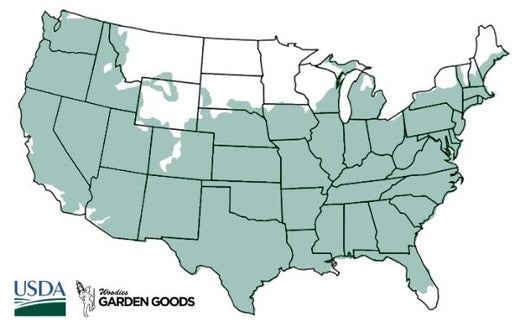
| Hardiness Zone: | 5-9 |
|---|---|
| Mature Height: | 2 to 3 Feet |
| Mature width: | 2 to 3 Feet |
| Classification: | Native Broadleaf Evergreen Shrub |
| Sunlight: | Full sun to part sun (4+ hours) |
| Foliage: | Green |
| Soil Condition: | Moist, acidic to average; tolerates wet sites |
| Water Require: | Average to consistent moisture |
| Resistance: | Native, Deer-resistant; boxwood-blight alternative |
| Landscape Use: | Low hedges, borders, foundation plantings, rain gardens, containers |
How to Care for Ilex glabra ‘Strongbox®’ (Strongbox Inkberry Holly)
Be sure to read our planting instructions to ensure a healthy and happy Strongbox® Inkberry Holly for years to come!
How should I plant Strongbox Inkberry Holly?
Choose a site with full sun to part sun and moist, acidic to average soil. Dig a hole about twice as wide as the root ball and just as deep. Set the plant so the top of the root ball is level with or slightly above the surrounding soil, then backfill with native soil amended with compost if needed. Water thoroughly to settle the soil around the roots. Finish with a 2–3 inch layer of mulch around the base, keeping it a couple inches away from the stems to prevent rot. Mulch helps conserve moisture, moderate soil temperature, and protect Strongbox’s shallow roots, which appreciate an even, cool root zone.
How often should I water Strongbox® Inkberry Holly after planting?
During the first growing season, water deeply 1–2 times per week, depending on weather and soil type, to keep the root zone evenly moist but not waterlogged. Inkberry tolerates moisture better than many evergreens but will not be happy in standing water for long periods. Once established, Strongbox can handle brief dry spells, but it still performs best with consistent moisture—especially in hot summers or on sandy soils. In droughty periods, a deep soak every 7–10 days helps maintain dense foliage and reduces stress.
When should I fertilize Strongbox Inkberry Holly?
Fertilize in early spring with a slow-release, balanced shrub or evergreen fertilizer, following label directions. This supports fresh green growth and overall vigor as the plant breaks dormancy. You can also top-dress annually with compost to gradually enrich the soil and support beneficial microbes. Avoid late-season high-nitrogen fertilizing, which can push soft growth that is more vulnerable to winter damage. Strongbox is naturally low-maintenance and doesn’t require heavy feeding to look great.

When and how should I prune Strongbox Inkberry Holly?
Strongbox has a naturally tight, rounded habit and often needs little to no pruning. If shaping is desired, prune in mid to late spring, after new growth starts to emerge, by lightly shearing or selectively trimming to maintain the mound. Avoid heavy pruning into old, leafless wood, as regrowth from bare stems can be slow. Instead, focus on light annual touch-ups to keep the plant looking crisp and uniform, similar to how you’d maintain a small boxwood hedge.








